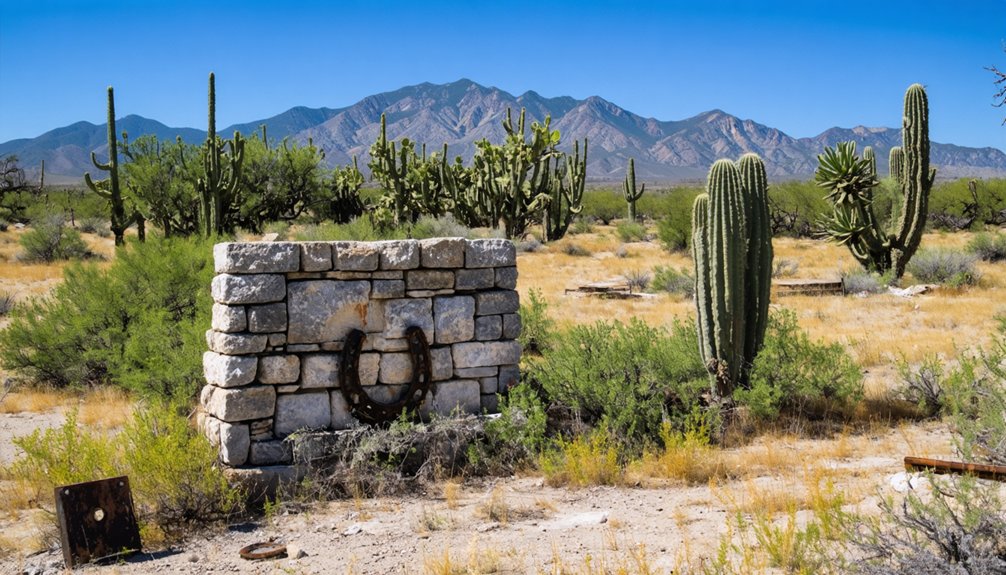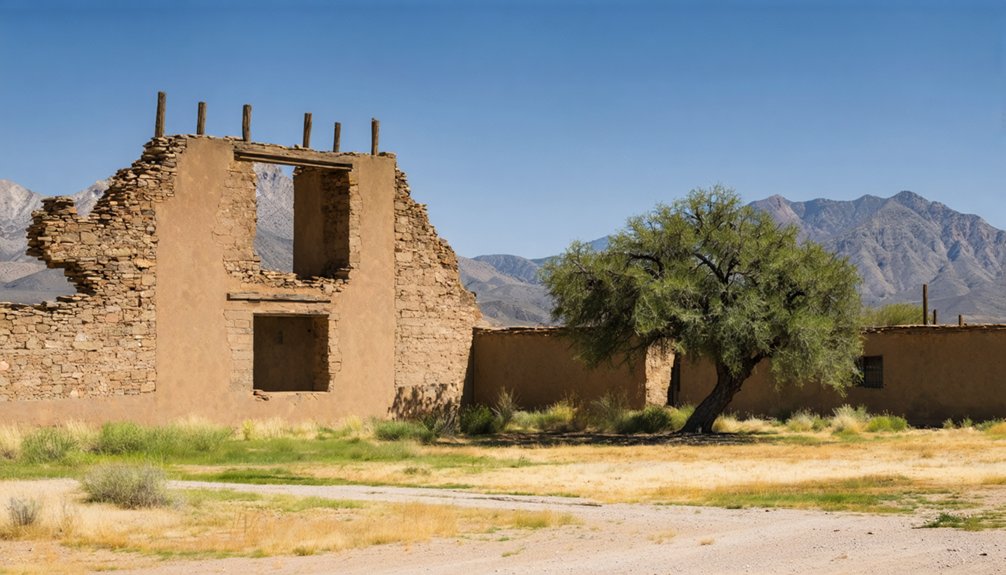Camp Crittenden began as a military outpost in 1867, strategically positioned to counter Apache raids near Sonoita, Arizona. After its 1873 closure, it transformed into a civilian settlement that flourished with the arrival of the New Mexico & Arizona Railroad in 1882. The town boasted stores, saloons, and the Crittenden Land & Cattle Company before gradually declining. Today, you’ll find only scattered ruins on private land, including foundations and a partially intact hotel. The site’s rich frontier history awaits exploration.
Key Takeaways
- Camp Crittenden was established in 1867 as a military post to intercept Apache raiding parties in southern Arizona.
- The camp closed in 1873 and later developed into a civilian settlement with the arrival of the railroad in 1882.
- At its peak, Crittenden had approximately 150 residents and served as a commercial hub with stores, restaurants, and saloons.
- The site now consists mostly of deteriorated adobe ruins, foundations, and a partially intact two-story hotel from 1885.
- Visitors need landowner permission to explore the private property site, which has no official markers or public facilities.
Military Beginnings: The Founding of Camp Crittenden (1867-1873)

As the tumultuous years of the Civil War came to a close, Camp Crittenden emerged as a critical military outpost in the Arizona Territory, established on August 10, 1867, at the head of Davidson Canyon.
You’ll find its founding significance lies in its strategic position overlooking three essential valleys: Babocomari, Sonoita, and Santa Cruz.
Named after Colonel Thomas L. Crittenden, a distinguished Civil War officer, the camp was built near the ruins of Fort Buchanan, which had fallen during Apache hostilities.
Captain Stephen G. Whipple led the initial command with Companies H and K.
The fort’s military legacy centers on protecting settlers from Apache warriors under Chief Cochise, who fiercely resisted reservation relocation.
The camp played a significant role during the Apache Wars, particularly between 1870 and 1871.
Constructed primarily of adobe, Camp Crittenden served as a frontier stronghold until its closure on June 1, 1873.
A historical marker was dedicated in 1968 to commemorate the important role Camp Crittenden played in the military history of the Arizona Territory.
Strategic Importance During the Apache Wars
Camp Crittenden’s location at the head of Davidson Canyon positioned it perfectly to intercept Apache raiding parties moving between their mountain strongholds and settler communities.
You’d find troops regularly departing from the fort to engage Cochise’s warriors, with Lieutenant H.B. Cushing‘s fatal 1871 skirmish marking one of the camp’s most significant military actions. During this period, the U.S. Army was deploying over 5,000 soldiers across the region to combat Apache resistance.
The military outpost played a crucial role during the longest war in United States history as Apache conflicts spanned from the 17th century into the early 20th century.
The fort’s presence drastically reduced Apache raids in the Babocomar, Sonoita, and Santa Cruz Valleys, allowing ranchers and farmers to establish permanent settlements in previously contested territories.
Military Position Analysis
Strategically positioned three miles from Sonoita, Arizona near Sonoita Creek, Camp Crittenden occupied essential defensive terrain that controlled access to multiple valleys crucial to settlement expansion.
The fort’s elevated location showcased practical military architecture, utilizing adobe construction that balanced defensive requirements against harsh environmental conditions.
Built just half a mile from the former Fort Buchanan, Camp Crittenden maintained American military presence in this important corridor of southern Arizona.
The fort, established on August 10, 1867, served as a critical military installation during the post-Civil War era in the Arizona Territory.
Its position controlled crucial transportation routes that would later influence State Route 82, markedly impacting troop logistics and supply movements.
From this vantage point, soldiers protected the Sonoita, Babocomari, and Santa Cruz Valleys—deterring Apache raiders while securing water resources essential to both military operations and civilian settlement efforts throughout the region.
The fort was active for only five years until unhealthy living conditions forced its abandonment in 1873, cutting short its intended role in the military strategy for the Arizona Territory.
Cochise Conflict Contributions
The Apache Wars found a significant flashpoint at Camp Crittenden, established in 1867 specifically to counter Cochise’s growing influence in southern Arizona.
You can trace the camp’s strategic importance to its location near the former Fort Buchanan site, positioned to disrupt Apache movement between three essential valleys.
Cochise tactics evolved in direct response to this military presence. His bands leveraged the rugged terrain for ambushes while conducting persistent raids on supply lines and patrols.
The camp’s operations intensified these conflicts, culminating in Lieutenant Cushing’s death during an 1871 skirmish with Cochise’s forces.
As part of a broader network of forts designed to restrict Apache resistance, Camp Crittenden helped control contested territory by limiting access to important water sources until its closure in 1873.
Settler Protection Efforts
While the Apache Wars intensified across southern Arizona, Camp Crittenden emerged as a critical defensive bulwark for pioneer settlements in 1867.
Located strategically near Sonoita Creek, the fort replaced Fort Buchanan to protect vulnerable communities in the Sonoita, Babocomari, and Santa Cruz Valleys.
You’d have found safety in the camp’s adobe-walled compound during periods of heightened Apache activity. The camp was specifically named to honor Colonel Crittenden, a distinguished Major General of U.S. Volunteers. Soldiers conducted regular patrols to guarantee settler safety throughout the region, launching campaigns against hostile bands in 1870-1871.
The military presence deterred raids on your homestead, while watchtowers and sentry posts monitored surrounding territories for potential threats.
Camp Crittenden’s community defense measures fostered regional development, encouraging further settlement and economic growth.
The fort’s strategic location influenced transportation networks, stabilizing the area until its closure in 1873.
From Military Post to Railroad Hub: The Birth of a Town
Following the formal closure of Camp Crittenden on June 1, 1873, due to deteriorating health conditions at the site, the area entered a period of change that would eventually birth a new civilian settlement.
Around 1882, the establishment of the New Mexico & Arizona Railroad transformed the landscape. You’d find a proper town emerging where soldiers once stood guard, with the railroad’s significance extending beyond mere transportation.
This hub connected mining operations in Harshaw, Lochiel, and Washington Camp to broader markets, fostering rapid community growth. Soon, Crittenden boasted stores, restaurants, saloons, and a post office.
The Crittenden Land & Cattle Company under Rollin R. Richardson became a key economic driver, while railroad construction created jobs. The town quickly became known as a major ore shipping point in Southern Arizona.
The population swelled to approximately 150 residents, reflecting the town’s prosperity as a regional supply center.
Economic Boom: Mining, Commerce and Daily Life

During Crittenden’s heyday from the 1880s through the early 20th century, mining activity formed the backbone of the local economy, with operations focused primarily on silver, lead, and zinc extraction.
The Trench Mine, with excavations reaching 400 feet deep, exemplified the area’s mining prosperity, especially during World War I when demand surged.
As you walked through town in 1883, you’d find a bustling community of 150 residents supported by two saloons, two restaurants, and a general store.
The railroad stop transformed Crittenden into an essential commercial hub serving nearby mining camps.
Community dynamics reflected the diverse population of miners, railroad workers, and Mexican laborers who gathered at local establishments after long workdays.
This economic significance fluctuated with metal prices, experiencing booms during wartime and declines during the Depression.
Decline, Abandonment and Natural Disasters
Camp Crittenden’s prosperous era stood in stark contrast to its military predecessor’s fate. The once-vital outpost officially closed on June 1, 1873, as Apache threats diminished and military strategy shifted elsewhere.
Unlike other frontier forts that evolved into settlements, Camp Crittenden‘s isolation and limited resources prevented any civilian change after the Army’s withdrawal.
The decline reasons were primarily strategic rather than catastrophic. No major disasters forced evacuation, but natural erosion took its toll after abandonment. Similar to Fort Buchanan, materials and buildings were deliberately destroyed when the military withdrew from the area.
Flash floods swept through the canyon location, while relentless weathering decimated the adobe structures. Wind, rain, and temperature extremes accelerated the site’s deterioration, leaving only crumbling walls and earthen mounds today.
The land eventually reverted to ranchland, further erasing traces of military occupation.
What Remains Today: Visiting the Ghost Town Ruins

Despite years of abandonment and natural deterioration, the former site of Camp Crittenden offers visitors a glimpse into Arizona’s frontier past through its scattered remains.
You’ll find mostly rubble, foundations, and walls reclaimed by vegetation, with the two-story hotel from 1885 (now minus its second floor due to earthquake damage) standing as the most intact structure.
The ruins exploration requires landowner permission since the site sits on private property north of Patagonia.
There are no official markers, facilities, or public access provisions. Visitor guidelines are straightforward: obtain permission first, expect no amenities, and prepare for a remote location with minimal infrastructure.
For the best experience, plan your visit during fall, winter, or spring to avoid summer heat while examining the cemetery and building remnants. Much like the former mining town of Metcalf after 1918, Camp Crittenden gradually declined until only structural remnants remained.
Frequently Asked Questions
Were Any Famous Battles Fought at Camp Crittenden?
No, you won’t find famous battles at Camp Crittenden. Its conflicts centered on strategic protection against Apache warriors, with military strategies focusing on defending settlers rather than engaging in significant confrontations.
What Happened to the Apache Population After Camp Crittenden Closed?
After Camp Crittenden closed, you’d witness Apache populations drastically decline as they were forcibly relocated to reservations. Despite devastating losses, Apache Resilience emerged through Cultural Preservation efforts that continue today.
Did Any Notable Historical Figures Visit Crittenden?
No notable visitors of historical significance came to Camp Crittenden. You won’t find records of Chief Cochise, Colonel Crittenden himself, or any prominent politicians ever visiting this frontier military outpost.
Were There Any Major Epidemics or Health Crises?
You’ll find no documented major disease outbreaks at Camp Crittenden. While southern Arizona faced smallpox and malarial fever during this period, records don’t show significant health impacts at this specific military post.
What Indigenous Tribes Occupied the Land Before Camp Crittenden?
The Chiricahua Apache primarily occupied this land, with some Mescalero and Western Apache presence. Earlier Hohokam culture and nearby Tohono O’odham history shaped the region before you’d find Camp Crittenden established there.
References
- https://en.wikipedia.org/wiki/Fort_Crittenden
- https://theclio.com/entry/60006
- https://patagoniaregionaltimes.org/glimpses-into-our-past-the-town-of-crittenden/
- https://www.gvrhc.org/Library/GhostTowns.pdf
- https://www.ghosttowns.com/states/az/crittendon.html
- https://www.hmdb.org/m.asp?m=27114
- https://southernarizonaguide.com/historic-military-forts-in-the-time-of-the-apache-wars/
- https://kids.kiddle.co/List_of_ghost_towns_in_Arizona
- https://www.hereandtherewithpatandbob.com/2020/05/camp-crittenden-arizona-where-apaches.html
- https://www.legendsofamerica.com/camp-crittenden-arizona/



